Shoji White by Sherwin-Williams is a soft, creamy off-white that brings warmth to any room. But picking the right colors to go with it can be tough.
Ever painted a room and felt something was missing? The right color partners make all the difference.
If you’re searching for the best Shoji White coordinating colors to create stunning, balanced interiors, you’re in the right place.
In this post, I’ll show you 10 designer-approved Shoji White coordinating colors that work beautifully together. These combinations have been tested in real homes with real results.
As an interior designer with 12 years of experience, I’ve used Shoji White in countless projects. I know which colors bring out its best qualities.
You’ll find bold accent walls, subtle trim colors, complementary furniture tones, and perfect kitchen and bathroom pairings.
Let’s find the perfect partners for your Shoji White spaces!
What Makes Shoji White Unique?
Shoji White isn’t just another white paint. It’s a warm, creamy off-white with subtle greige undertones that make it special.
I love how it sits between white and beige. Not too stark, not too yellow.
Wondering about the numbers? Shoji White has an LRV (Light Reflectance Value) of 74. This means it’s light and airy but won’t blind you like pure white might.
For the tech-minded folks:
- RGB values: 237, 234, 224
- Hex code: #EDEAE0
- VOC: Less than 50 g/L (low VOC formula)
Think of Shoji White as that perfect middle ground. It reflects plenty of light to make rooms feel open. Yet it has just enough color to feel cozy.
Understanding Shoji White’s undertones helps you choose the most flattering coordinating colors.
But what about your space? The right partner colors can make Shoji White sing.
10 Shoji White Coordinating Colors for Stunning Spaces
I’ve spent years testing color combinations with Shoji White. Here are my top 10 picks that truly work well together.
1. Urbane Bronze (SW 7048)
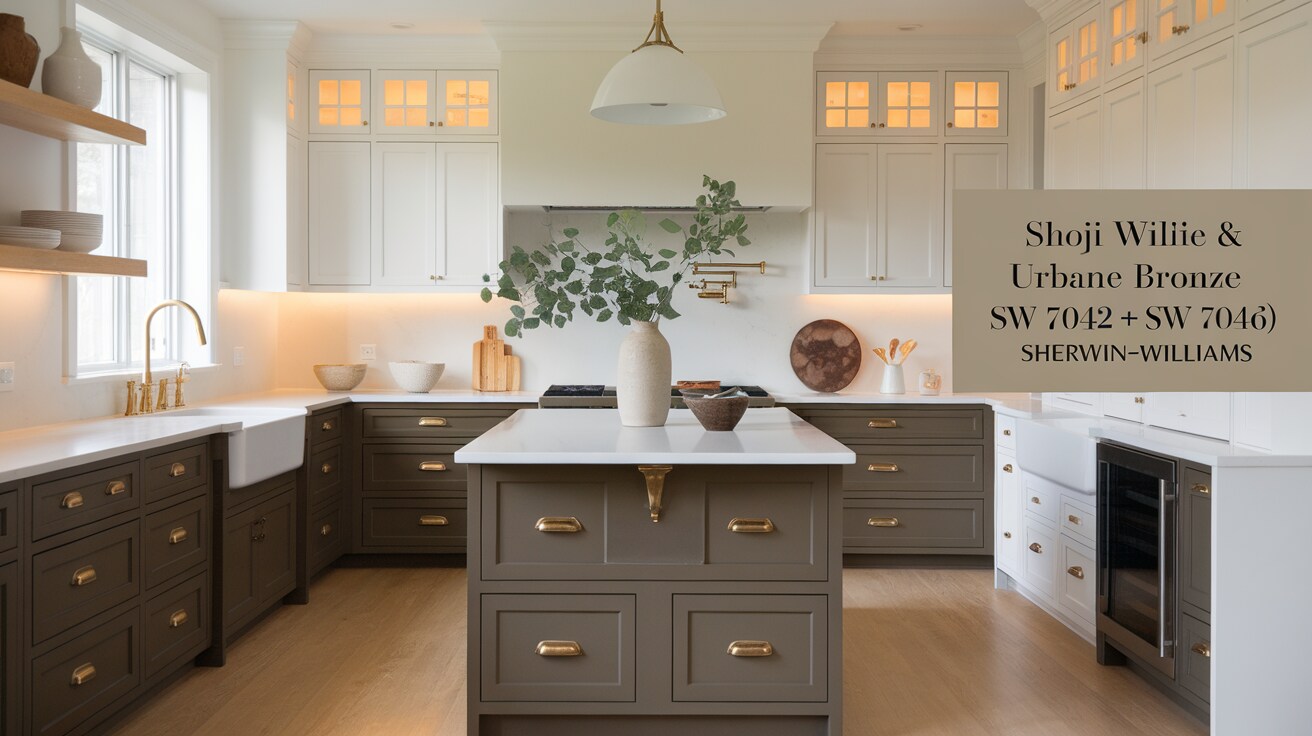
Urbane Bronze adds dramatic depth when paired with Shoji White. This rich, dark color has:
- LRV: 8
- RGB: 82, 79, 69
- VOC: Less than 50 g/L
Why it works: The cool undertones in Urbane Bronze balance Shoji White’s warmth perfectly.
I recommend using Urbane Bronze for accent walls in living rooms or dining areas. You can also try it on kitchen islands, front doors, or window frames. The contrast makes both colors pop.
For a bold look, paint your lower kitchen cabinets Urbane Bronze while keeping uppers in Shoji White. This grounds the space while maintaining brightness.
2. Alabaster (SW 7008)
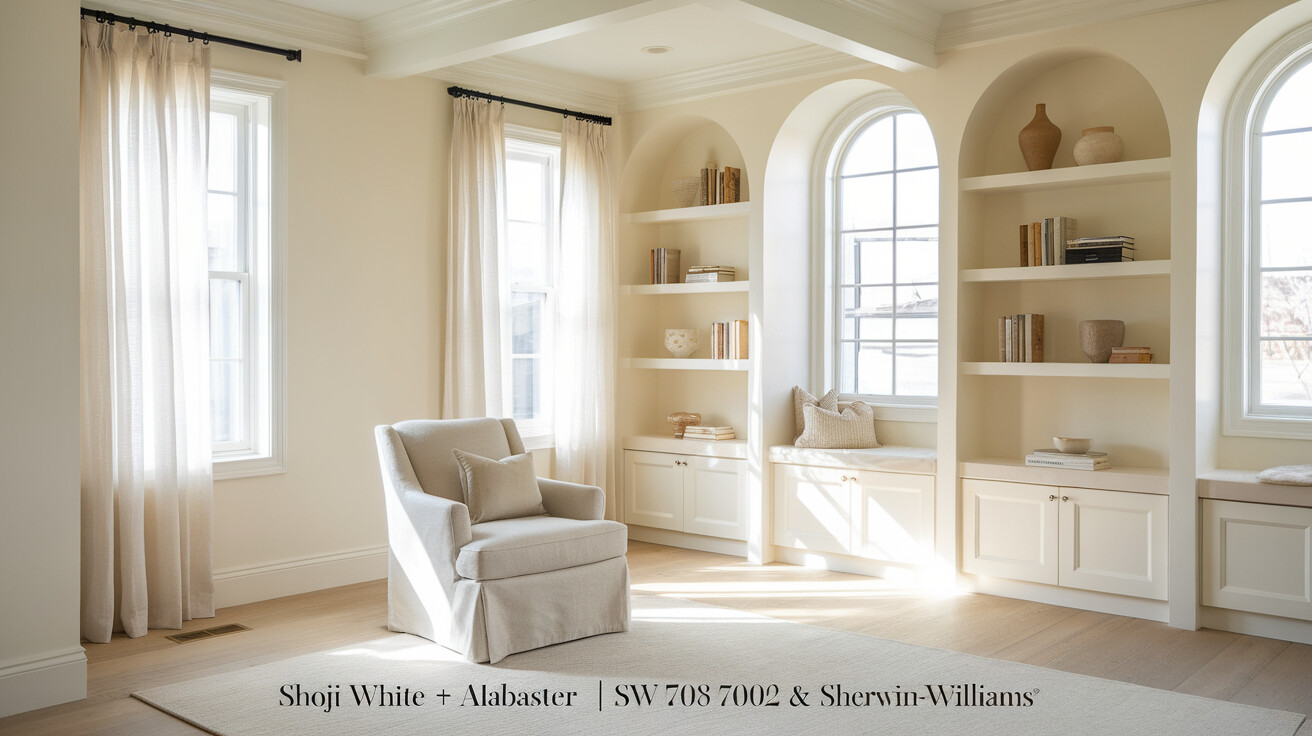
Alabaster is a creamy white that pairs beautifully with Shoji White for subtle contrast.
- LRV: 82
- RGB: 237, 234, 224
- VOC: Less than 50 g/L
Why it works: Both colors share warm undertones, but Alabaster is slightly brighter.
Use Alabaster for trim, ceilings, and crown molding next to Shoji White walls. The small shift between these colors creates depth without stark contrast.
I often suggest Alabaster for built-ins and shelving when you have Shoji White walls. It makes these features stand out just enough.
3. Accessible Beige (SW 7036)
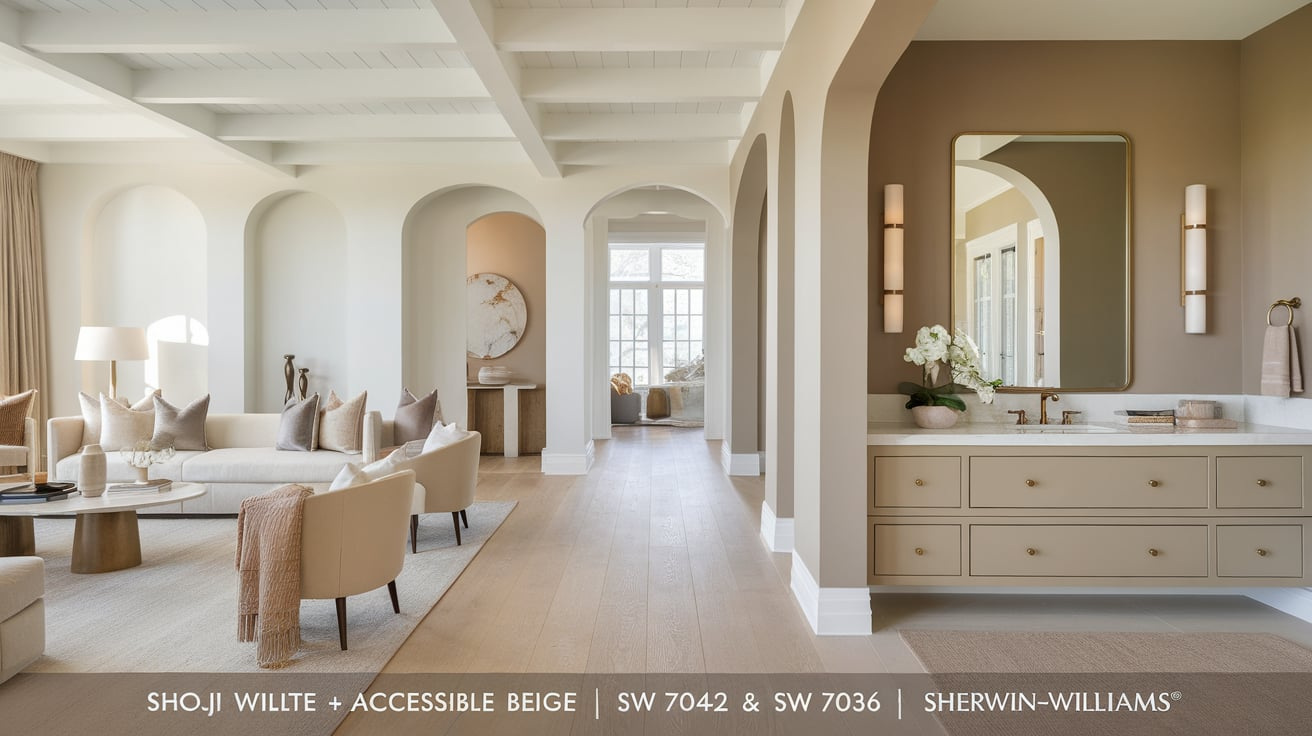
Accessible Beige creates a soft, neutral flow with Shoji White.
- LRV: 58
- RGB: 212, 204, 187
- VOC: Less than 50 g/L
Why it works: The greige undertones in both colors create a seamless transition.
I love using Accessible Beige in open floor plans where you need related but distinct colors. Try Shoji White in living areas with Accessible Beige in adjoining hallways or dining rooms.
This combo works well in bathrooms too – Shoji White for walls and Accessible Beige for vanities.
4. Evergreen Fog (SW 9130)
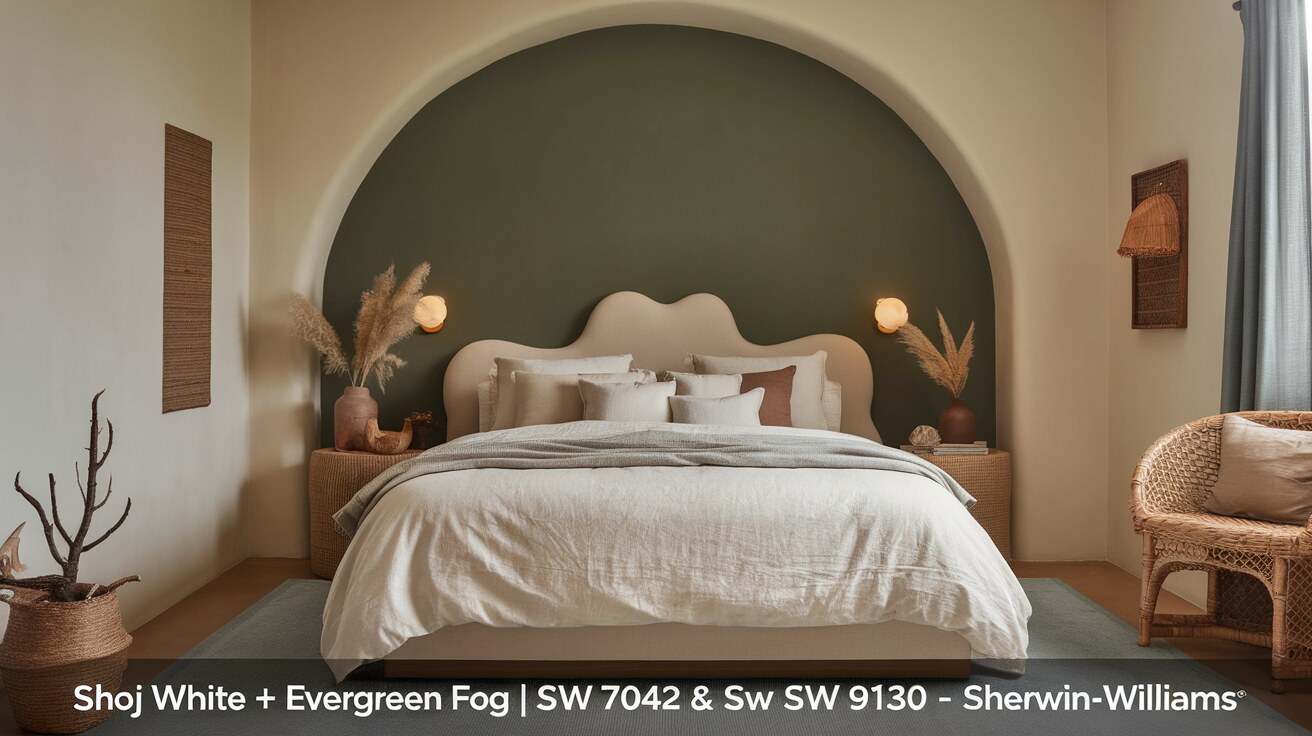
Evergreen Fog is a dusty, muted green that brings nature indoors alongside Shoji White.
- LRV: 30
- RGB: 164, 167, 151
- VOC: Less than 50 g/L
Why it works: This green has gray undertones that complement the subtle greige in Shoji White.
Use Evergreen Fog on kitchen cabinets with Shoji White walls for a fresh, updated look. Or try an Evergreen Fog accent wall in a bedroom with Shoji White on the remaining walls.
I’ve found this color works amazingly well on exterior trim when your siding is Shoji White.
5. Naval (SW 6244)
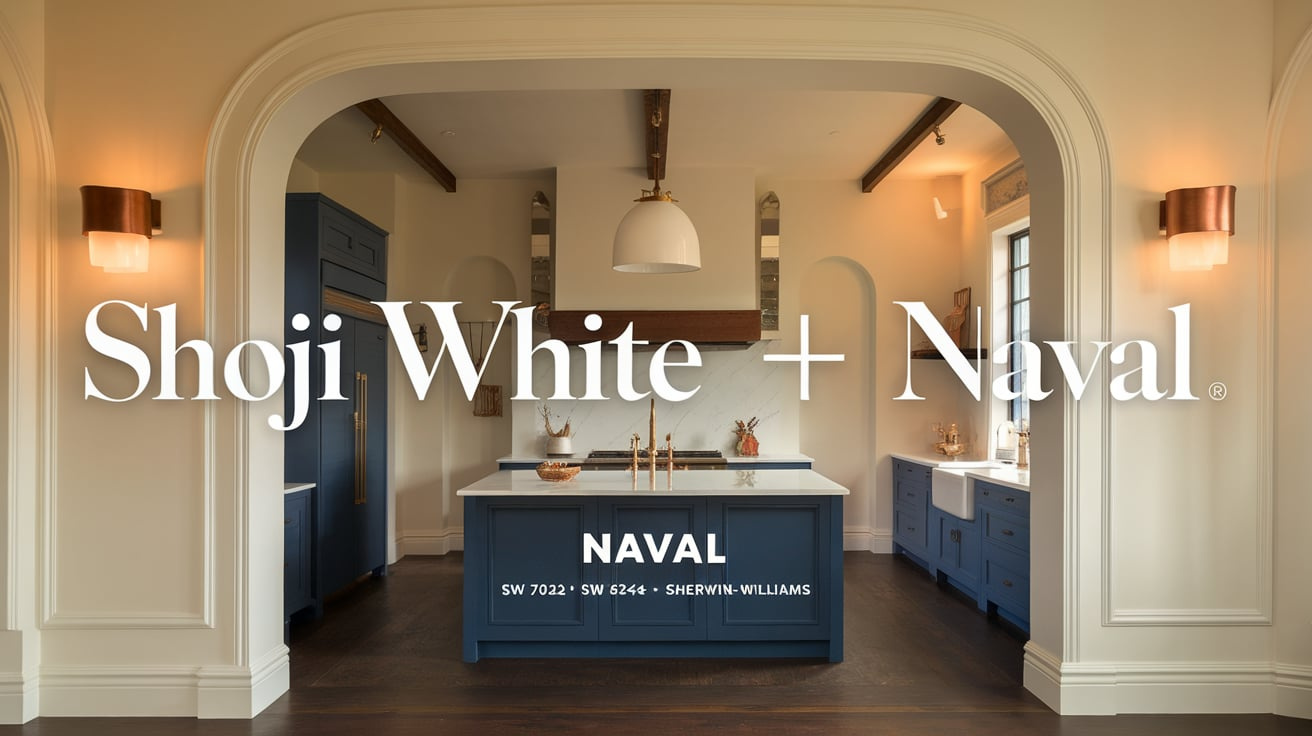
Naval creates a rich navy contrast that makes Shoji White pop.
- LRV: 4
- RGB: 47, 65, 84
- VOC: Less than 50 g/L
Why it works: This deep blue provides a strong contrast without feeling harsh.
Try Naval on a kitchen island, bathroom vanity, or built-in bookcase with Shoji White surroundings. The combination feels both classic and current.
For a dramatic bedroom, paint one wall Naval with the rest in Shoji White. Add brass accents to complete the look.
6. Repose Gray (SW 7015)
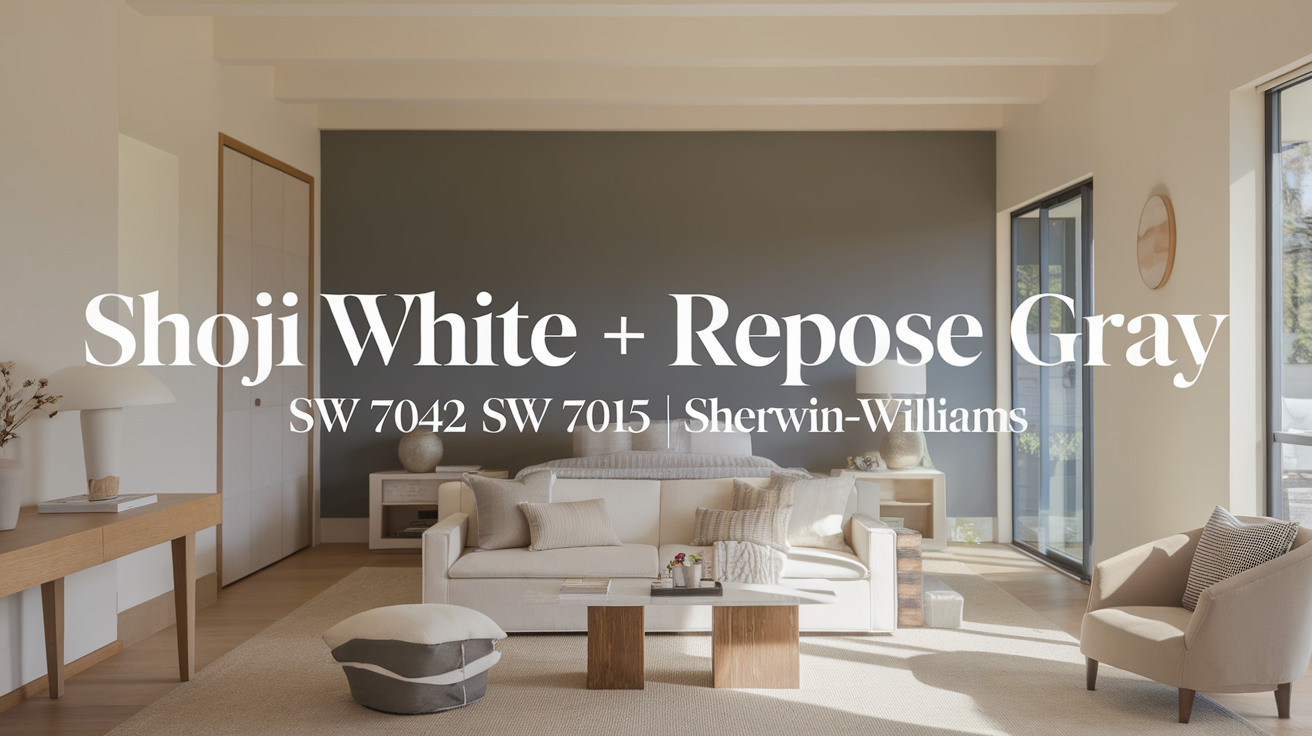
Repose Gray offers a modern, cool-neutral companion to Shoji White.
- LRV: 58
- RGB: 204, 201, 192
- VOC: Less than 50 g/L
Why it works: While Shoji White leans warm, Repose Gray has cool undertones for balance.
I recommend using these colors in a split complementary way – Shoji White for main living areas with Repose Gray in bedrooms or home offices.
They also work well vertically – try Repose Gray below chair rails with Shoji White above.
7. Warm Stone (SW 7032)
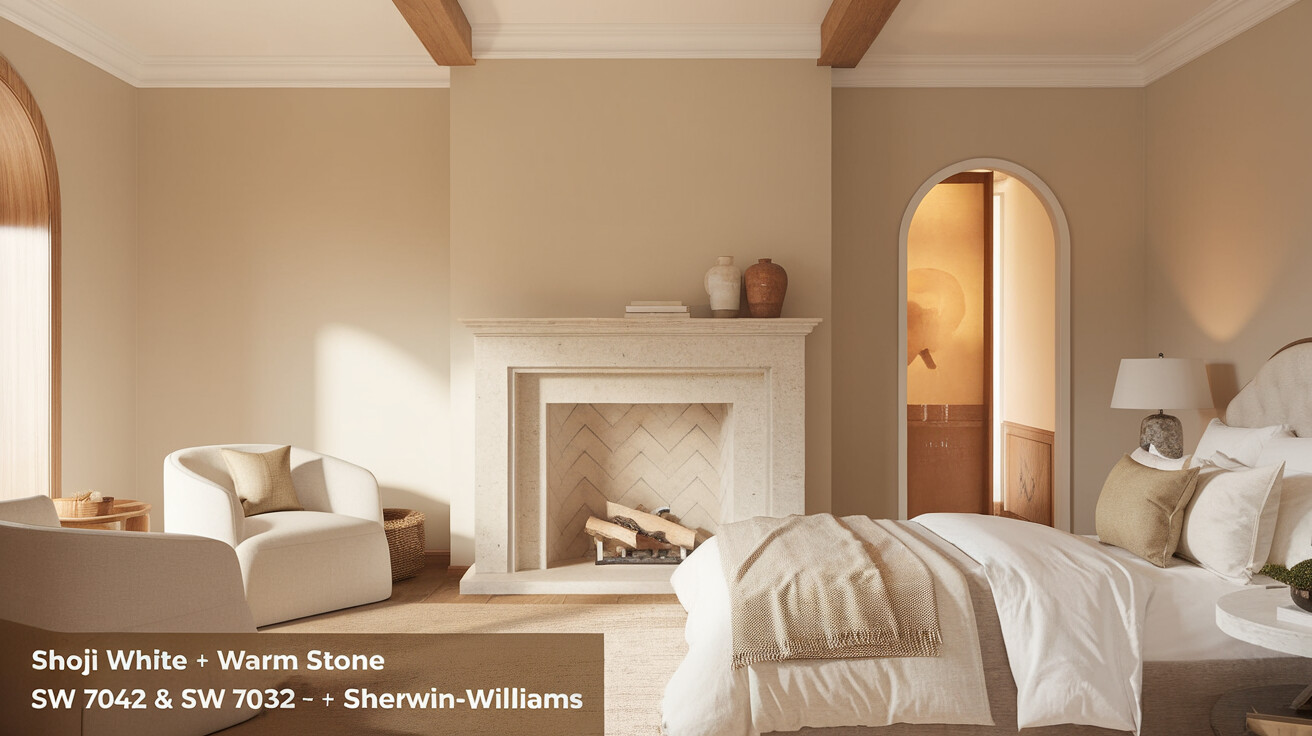
Warm Stone creates a cozy, grounded backdrop with Shoji White.
- LRV: 49
- RGB: 193, 181, 165
- VOC: Less than 50 g/L
Why it works: The earthy tan undertones complement Shoji White’s creaminess.
Use Warm Stone on bedroom walls with Shoji White trim for a cozy retreat. Or reverse it – Shoji White walls with Warm Stone on doors and window frames.
This color also works wonderfully on fireplace surrounds when your walls are Shoji White.
8. Inkwell (SW 6992)
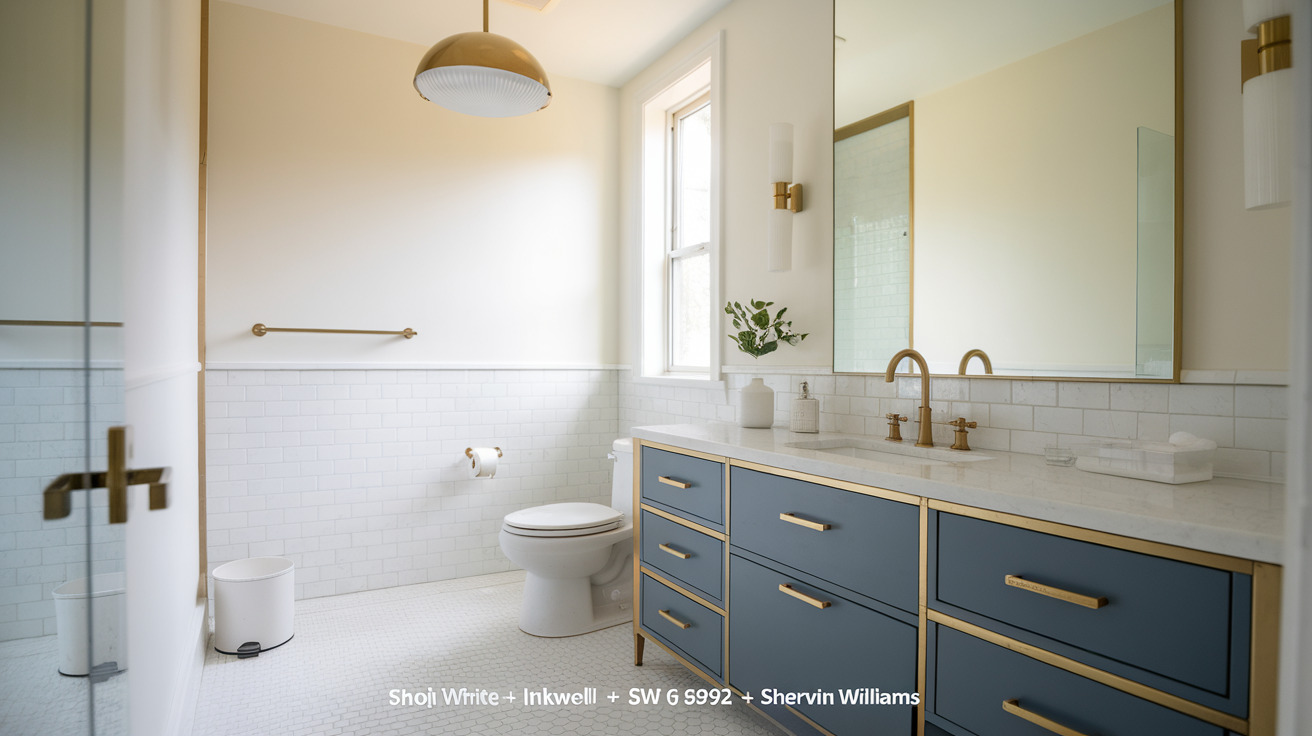
Inkwell is a nearly-black shade that creates bold contrast with Shoji White.
- LRV: 4
- RGB: 47, 52, 57
- VOC: Less than 50 g/L
Why it works: The dramatic contrast makes both colors more impactful.
I love using Inkwell on interior doors with Shoji White walls – it makes a statement without overwhelming the space.
Try this combination in a bathroom with Shoji White walls and an Inkwell vanity. Add brass hardware for warmth.
9. Sage Green Light (SW 2851)
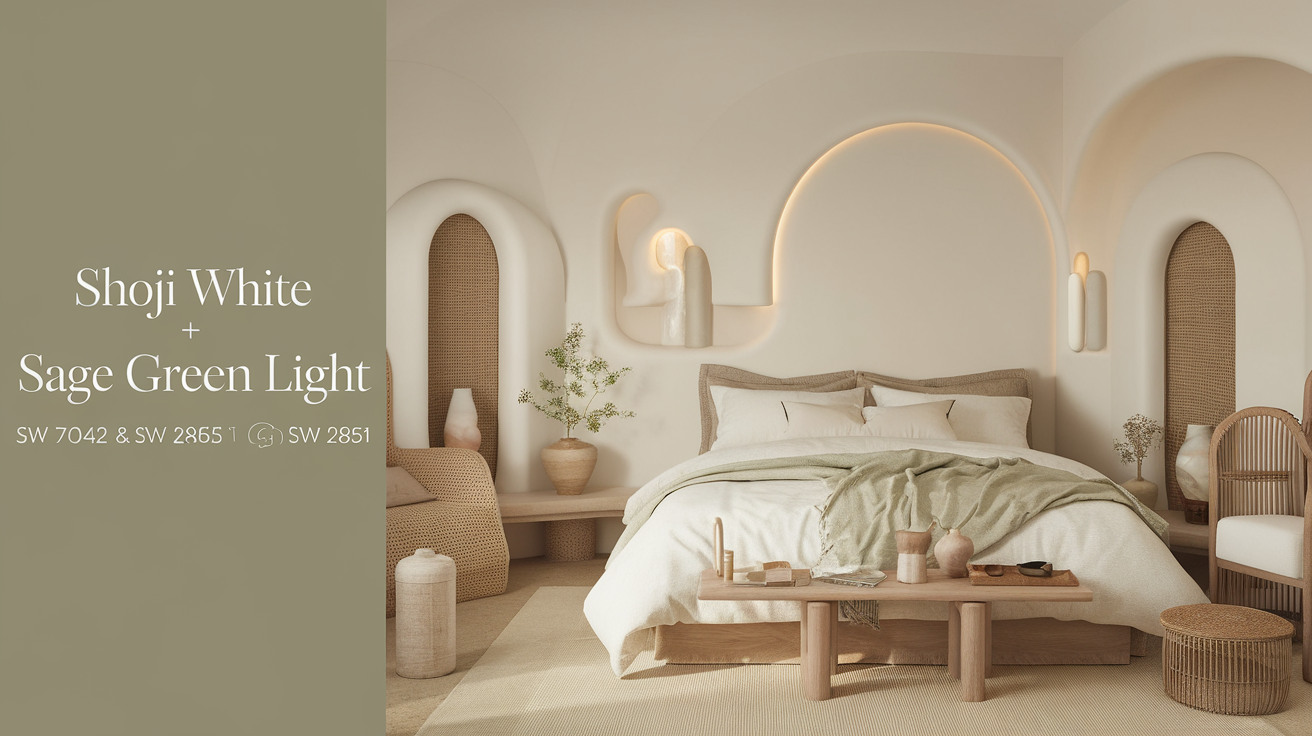
Sage Green Light offers an earthy balance that works especially well in bedrooms and kitchens.
- LRV: 54
- RGB: 198, 198, 181
- VOC: Less than 50 g/L
Why it works: This soft green has enough gray to complement Shoji White’s subtle undertones.
Paint kitchen cabinets Sage Green Light with Shoji White walls for a fresh, timeless look. Or use it on bedroom furniture against Shoji White walls.
I often recommend this color for mud rooms and laundry spaces with Shoji White trim.
10. Greek Villa (SW 7551)
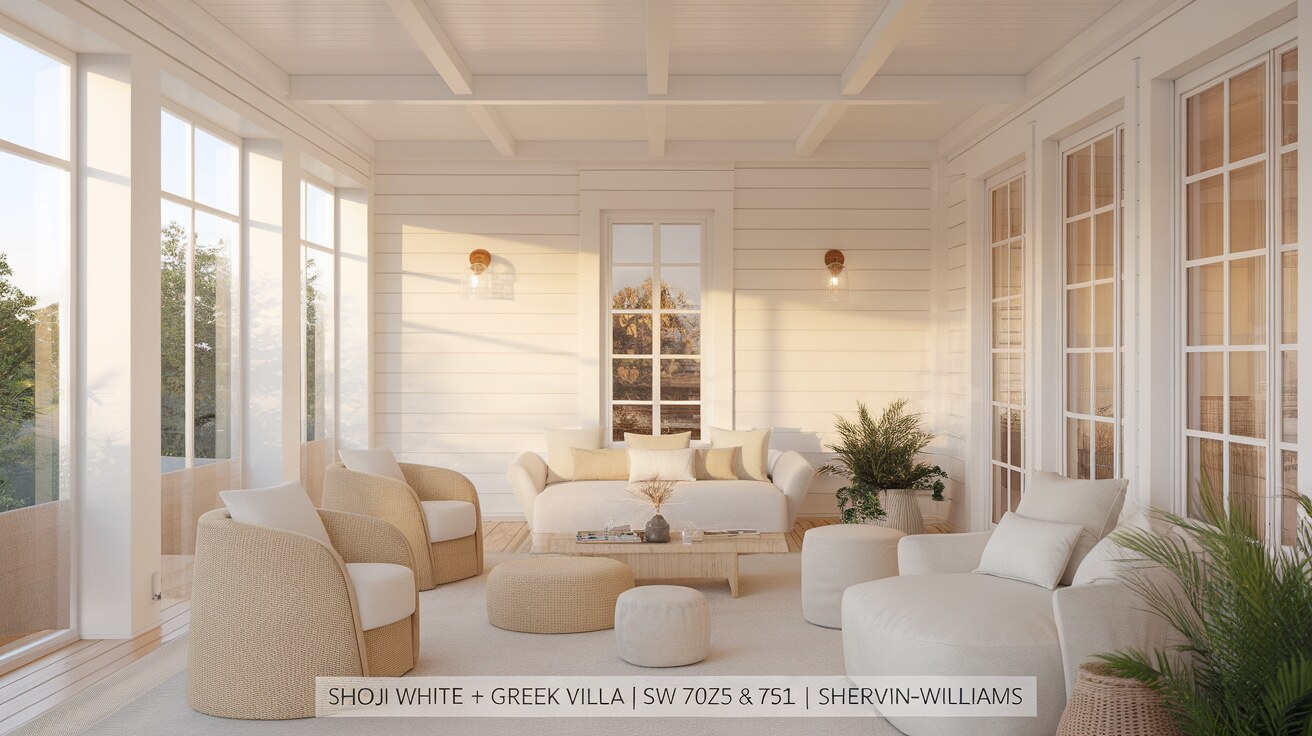
Greek Villa creates crisp but warm white layering with Shoji White.
- LRV: 84
- RGB: 242, 236, 228
- VOC: Less than 50 g/L
Why it works: Slightly brighter than Shoji White but with similar warm undertones.
Use Greek Villa on the ceilings and trim with Shoji White walls. The subtle difference adds depth without obvious contrast.
This combination works exceptionally well in sunrooms, where the slight variations become more noticeable with changing light.
How to Style Spaces with Shoji White and Its Coordinating Colors?
Styling with Shoji White is simpler than you might think. I’ve used it in dozens of homes with great results.
First, think about layers. Paint is just the start. Your furniture, fabrics, and decor all play a role in the final look.
Mix Your Textures
Shoji White comes alive when paired with different textures. Try these combinations:
- Smooth Shoji White walls with rough stone accents
- Matte Shoji White cabinets against glossy tile backsplashes
- Soft fabric curtains against Shoji White trim
The contrast makes both elements stand out.
Natural Materials Are Your Friends
Shoji White loves natural materials. I mean, love them.
Wood tones look fantastic against Shoji White walls. Dark walnut creates drama. Light oak keeps things bright and airy.
Other materials that work well:
- Leather (both tan and dark brown)
- Linen upholstery in natural tones
- Jute or sisal rugs
- Woven baskets
- Stone countertops
These materials bring out the warm undertones in Shoji White without fighting against them.
Lighting Changes Everything
Your lighting affects how Shoji White looks. This is key!
In bright, sunny rooms, Shoji White shows its true colors. But in low-light rooms, choose lighter coordinating shades like Alabaster or Greek Villa to prevent Shoji White from feeling too beige.
North-facing rooms? Add warmer light bulbs (2700-3000K) to balance the cool natural light.
South-facing rooms? Shoji White will look its creamiest here. You can pair it with cooler colors like Naval or Repose Gray for balance.
What about your space? The right combination depends on your unique lighting situation.
Conclusion
Shoji White stands as one of the most adaptable paint colors available today. It brings warmth and light to spaces without overwhelming them.
The right coordinating colors transform Shoji White from simple to stunning. Each pairing creates a unique feel, from calm and subtle to bold and dramatic.
I recommend testing swatches in your own space. Watch how they change throughout the day as light shifts.
What Shoji White combinations are you considering? Have you tried any of these pairings? Share your experiences or questions in the comments below.
Your perfect Shoji White palette is waiting to be discovered!
FAQs
What’s the best trim color for Shoji White?
I recommend Alabaster (SW 7008) or Greek Villa (SW 7551). Both offer subtle contrast while maintaining warmth. They’re bright enough to define edges without harsh transitions.
Can Shoji White work with cooler tones like navy or gray?
Absolutely! I’ve paired Shoji White with Naval and Repose Gray in many homes. The warm-cool tension creates beautiful depth and balance. These combinations often become client favorites.
Is Shoji White good for open floor plans?
Shoji White excels in open spaces. It flows naturally between rooms while maintaining visual interest. I use it often with consistent trim and accent colors throughout.
How do I keep Shoji White from looking too beige?
Balance is key. Add crisp whites like Pure White for trim. Include charcoal or navy accents. Good lighting makes a huge difference. Natural light brings out its best qualities.

